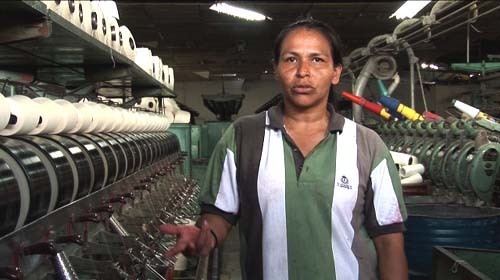The Business of Art: Considering Curatorial Objectivity
Dario Azzellini and Oliver Ressler. 5 Factories—Worker Control in Venezuela (2006). Still from a color video. From the exhibition Now-Time Venezuela, Part 1. All images courtesy BAM/PFA.
On April 28, 2006, Chris Gilbert resigned from his post as Berkeley Art Museum’s MATRIX curator. After holding the position since September of 2005, Gilbert resigned when the museum’s administration demanded that he remove from the wall text of his exhibition cycle — Now-Time Venezuela: Media Along the Path of the Bolivarian Process — language in which he proclaims the program’s solidarity with the current Bolivarian Revolution in Venezuela. The second of the two-part exhibition series, which focuses on the Caracas-based community television station Catia TVe, is on view at the museum through July 16.
Gilbert’s act of resistance has instigated some provocative debate on internet message boards (with artist-theorists like Gregory Sholette and Martha Rosler contributing) on the potential of “radical” curatorial practice within an institutional framework and on whether or not a curator can be expected to adhere to standards of objectivity.
Chris Gilbert’s explanation of his resignation as MATRIX curator at the Berkeley Art Museum (BAM) has been posted in numerous places on the internet, including Indybay.org and Rhizome.org. The incident stemmed from Gilbert’s two exhibitions this year documenting Venezuela’s Bolivarian revolution. The spring exhibition Now-Time Venezuela, Part 1: Worker-Controlled Factories consisted of a number of single-channel videos projected on large flatscreen monitors set at angles, creating a dynamic series of immersive images. With a bench in front of each screen, viewers could listen with headphones to the ambient factory sound and the dialogue of workers and managers who contribute their own observations on their experiences and on the development of the cooperatives examined in Dario Azzellini and Oliver Ressler’s video 5 Factories—Worker Control in Venezuela. Now-Time Venezuela, Part 2: Revolutionary Television in Catia shows a selection of the programming made by Catia TVe, a Caracas television station whose programs are created by community organizers and activists.
Summarizing the impetus for his resignation, Gilbert wrote, “In particular the museum administrators—meaning the deputy directors and senior curator collaborating, of course, with the public relations and audience development staff—have for some time been insisting that I take the idea of solidarity, revolutionary solidarity, out of the cycle. For some months, they have said they wanted ‘neutrality’ and ‘balance’ whereas I have always said that instead my approach is about commitment, support, and alignment—in brief, taking sides with and promoting revolution.”
It appears that an impasse over the inclusion of the words “revolutionary solidarity” in the wall text for the show precipitated Gilbert’s resignation: “Their plan was to replace the phrase ‘in solidarity’ with revolutionary Venezuela with a phrase like ‘concerning’ revolutionary Venezuela—or another phrase describing a relation that would not be explicitly one of solidarity.”1 The wall text in question was ultimately maintained in the gallery throughout Now-Time Venezuela, Part 1.
Some in the “art subculture,” to use Gilbert’s preferred terminology, have focused on whether or not Gilbert may have shined the spotlight too brightly on himself with his resignation. A post attributed to Martha Rosler at Nettime.org observes, “This appears to be a case of someone stepping in front of the material they wish to put before the public and thereby, as they say, making himself (or his labels) the story.” An argument can be made, though, that larger issues are at stake in relation to Gilbert’s resignation and unwavering stance on the maintenance of his wall text: specifically, curatorial and artistic freedom as well as the notion of curatorial objectivity—in other words, whether or not a curator should assume unambiguous ethical positions and attempt to persuade viewers of their validity—all of which contribute to the overarching theme: class interest. Artist and writer Gregory Sholette defends Gilbert in a posting on Nettime.org, writing, “Gilbert’s resignation and the letter that explains his deed are part and parcel of one person’s effort to radically transform the role of arts administrator into that of engaged, political participant.”
Simone de Beauvoir, in The Ethics of Ambiguity, details the need for all people to help others attain freedom as contingent to attaining it themselves. This philosophy can be linked to the responsibility of viewers/readers—the need to not rely on just one source, to not assume that the authoritative voice contains the only valid point of view.
BAM should be commended for making a sincere attempt (not only through the exhibition but through panel discussions as well) to confront the issue of a social and political movement antithetical to standard US free market capitalism. In a climate of intense pressure from the right over cultural and political expression (for example, the institutional self-censorship the artist Guillermo Gómez-Peña3 has written on or the FBI and Joint Terrorism Task Force raid on Critical Art Ensemble member Steve Kurtz, a glaring example of overreach in the US government’s War on Terror), institutions have become very careful about protect their funding. Given the evidence we have through the Freedom of Information Act that the US government spent $2.2 million between 2000 and 2003 to train or finance anti-Chávez parties and organizations in Venezuela, an exhibit of this type is likely to attract unwanted scrutiny.4
An associate curator I spoke to at a San Francisco-based museum felt that the approach of a museum should be to present various points of view, and that if one side is represented, the other side should be as well, if not in the same exhibit or at the same time, in a subsequent show. This viewpoint corresponds roughly with the notion of objectivity or balance in journalism, and also to the prevailing journalistic practices in the mainstream media, which have developed a further desire for “balance” in the wake of pressure from the right. At PBS in 2005, debate over advocacy journalism precipitated the weakening of the presence and funding for Bill Moyers’ “NOW!” and increased time for a show hosted by Tucker Carlson.
Alternative media in the US and some media in Europe is often advocacy journalism, a fact-based journalism that often seeks to support a point of view that serves public interest. This is analogous to the type of curating embodied in the Gilbert’s exhibit. This is also related to the strong authorial curating pioneered by Harald Szeemann, arguably the first independent curator. Twentieth-century philosophers, of course, provided the precursor for this kind of work. Michel Foucault’s analysis of historical and political discourse indicated that the truth is not absolute, and Walter Benjamin encouraged a reading of historical events through the lens of class interests. Transparency in communication of intent and admission of bias would be in line with this approach. Clarity in expressing a point of view would allow for better objectivity, giving validation to Gilbert’s insistence on clearly expressing the bias of the exhibition.
Curator Mari Carmen Ramirez also supports the authorial view of the independent curator: “Perhaps the most significant aspect of the constellation model is its unapologetic assertion of the relative and arbitrary nature of curatorial authority…It is the curator, and not some pre-established teleological myth or grander narrative, who establishes the conceptual coordinates for the understanding and appreciation of the artworks and individuals included within its restricted parameters.”
Did BAM consider putting up a disclaimer at the door? In the essay “Cyber-Placazo: Gómez-Peña on Censorship in the U.S.” performance artist Guillermo Gómez-Peña writes, “Sometimes the presenter’s ‘concerns’ might be addressed with an emphatic disclaimer placed at the entrance of the gallery or theatre, something like: ‘There will be nudity and/or adult content and/or political images which you may find offensive…’ If the museum director or presenter is a hip Vato, he may let me write my own disclaimer, Gómez-Peña style. I always try to create a funny disclaimer that heightens the specific fears of the curator or the institution—something like: ‘You are about to witness chicken nudity and unnecessary Mexican violence. Think twice before you cross this border.’ Or, ‘Patriots should think twice before entering into an internationalized space.’ Or, ‘The artists are not responsible for identity crises audience members might endure during the performance.”6
Regardless of Gilbert’s intentions, he has created the kind of dialogue and investigation into his subject matter that any curator would be happy to instigate. In reading the online comments following Gilbert’s explanatory letter, I came across one that said that Venezuelans are being enslaved by Chávez’s regime and that three of the factories shown in Azzellini and Ressler’s 5 Factories are now out of business. In checking secondary sources, I found that at least one of these factories no longer has an internet presence. Then I discovered a blog on Salon.com detailing many reasons, including the inheritance of obsolete machinery and markets destroyed by globalization, that would contribute to the likelihood that these businesses would fail. The article was written in May of 2005.7 In a fascinating piece that debates the realities of social and economic change engendered through cooperatives in Venezuela (footnoted by Gilbert in his exhibition materials), Camila Pineiro Harnecker writes, “Even if many of the new cooperatives fail, it doesn’t mean that the promotion of cooperatives is an undesirable development policy. Rather, it shows that development requires effective state support in providing both education and resources to break with the cycle of poverty and underdevelopment.”8
And consider the following, generated by the World Bank and dated June 3, 2006: “The statistical evidence that we have compiled shows that from 1995 to 2005 the number of homes under the poverty line has decreased.” The numbers went from more than 40% to 30%.9 Evidently, in the two decades before Chavez assumed power in 1998, an estimated 80% of the population lived in poverty.10 I never thought I would be quoting the World Bank.
Cheryl Meeker is a San Francisco-based artist and writer, is a co-publisher of the artist-run collective Stretcher.org, and is a Green Party member.





